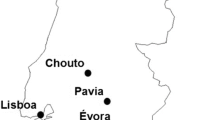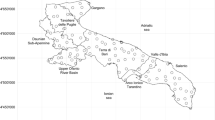Abstract
In this paper, climatic variability influence on detected drought spatio-temporal variability and characteristics by Standardized Precipitation Index (SPI) and Reconnaissance Drought Index (RDI) are investigated using data from ten synoptic weather stations with various climatic conditions in Iran. Data record lengths of 34-, 44-, 54- and 64-years are used to represent the impact of climatic variability. Long- and short-term temporal trends of generated SPI and RDI series are, respectively, assessed by the Mann–Kendall and Lepage tests. Drought characteristics, i.e., number and maximum duration of severe drought event (SDE) and extreme drought event (EDE), are also investigated. Dispersion from the mean value of computed drought characteristics and the number of short-term temporal trends obtained at different record lengths are used to assess the influence of climatic variability. Dispersions are measured by normalized root mean squared error (NRMSE), with values < 10% indicating no climatic variability influence. According to the Mann–Kendall tests, SPI/RDI results are not generally influenced by climatic variability in detecting (not detecting) long-term temporal trends. The Lepage tests show that increased record length increases the number of short-term temporal trends (change-points), slightly. However, climatic variability influence is not verified by the NRMSE values. The NRMSE values verify that climatic variability influences SPI and RDI results of numbers of SDEs and EDEs in some stations. Except for one station, SPI and RDI results of maximum durations of SDEs and EDEs are not influenced by climatic variability. According to the present study, climatic variability can influence SPI and RDI analysis of drought spatio-temporal variability/characteristics. Emphasizing the challenge in drought investigations as new sources of data become available. More importantly, the efficiency of the artificial neural network (ANN) model is investigated to determine the nonlinear relationship between the inputs and outputs variables.




















Similar content being viewed by others
References
Ahmad K, Shahid S, Chung E-S, Wang X-J, Bin Harun S (2019) Climate change uncertainties in seasonal drought severity-area-frequency curves: case of the arid region of Pakistan. J Hydrol 570:473–485
Allen RG, Pereira LS, Raes D, Smith M (1998) Crop evapotranspiration: guidelines for computing crop water requirements. Irrigation & drainage. Paper 56. FAO, Rome
Amandeep K, Sandeep KS (2019) Could- Fog based framework for drought prediction and forecasting using artificial neural network and genetic algorithm. J Exp Theor Artif Intell 32(2):273–289
Asadi Zarch MA, Sivakumar B, Sharma A (2015) Droughts in a warming climate: a global assessment of Standardized precipitation index (SPI) and Reconnaissance drought index (RDI). J Hydrol 526:183–195
Avilés A, Solera A, Pedro-Monzonis M (2018) Integrated methodological framework for assessing the risk of failure in water supply incorporating drought forecasts. Case Study: Andean Regulated River Basin. Water Resour Manag 32(4):1209–1223
Azizi E, Tavakoli M, Karimi H, Faramarzi M (2019) Evaluating the efficiency of the neural network to other methods in predicting drought in arid and semi- arid regions of western Iran. Arab J Geosci 12:489
Banimahd SA, Khalili D (2013) Factors influencing Markov Chain predictability characteristics, utilizing SPI, RDI, EDI, and SPIE drought indices in different climatic zones. Water Resour Manag 27:3911–3928
Bazrafshan J, Hejabi S (2018) A non-stationary reconnaissance drought index (NRDI) for drought monitoring in a changing climate. Water Resour Manag 32(8):2611–2624
Chen YD, Zhang Q, Xu CY, Yang T, Chen XH, Jiang T (2009) Change-point alterations of extreme water levels and underlying causes in the Pearl River delta, China. River Res Appl 25(9):1153–1168. https://doi.org/10.1002/na.1212
Dehghani F, Dehghani M (2020) Predicting drought based on SPI and RDI on 3-month scale using artificial neural network and decision tree. In: 12th National Congress on Civil Engineering, Tabriz
Farahani MA, Khalili D (2013) Seasonality characteristics and Spacio-temporal trends of 7-day low flows in a large, semi-arid watershed. Water Resour Manag 27:4897–4911
Han Z, Long D, Huang Q, Li X (2019) Simulating regulated streamflow using satellite observations and a hydrologic model. AGUFM 2019:H52C–H6
Hargreaves GH, Samani ZA (1982) Estimating potential evapotranspiration. J Irrig Drain Eng 108(3):225–230
Helsel DR, Hirsch RM (2002) Statistical methods in water resources. U.S. Geological Survey Techniques of Water-Resource Investigations, Book 4, chap. A3
Johari A, Nejad AH (2015) Prediction of soil-water characteristic curve using gene expression programming. Iran J Sci Technol Trans Civil Eng 39(C1):143
Kendall MG (1975) Rank correlation methods, 4th edn. Charles Griffin, London
Khalili D, Farnoud T, Jamshidi H, Kamgar-Haghighi AA, Zand-Parsa S (2011) Comparability analyses of the SPI and RDI meteorological drought indices in different climatic zones. Water Resour Manage 25:1737–1757
Khan MI, Liu D, Fu Q, Saddique Q, Faiz MA, Li T, Qamar MU, Cui S, Cheng C (2017) Projected changes of future extreme drought events under numerous drought indices in the Heilongjiang Province of China. Water Resour Manag 31(12):3921–3937
Khanmohammadi N, Rezaie H, Behmanesh J (2018) The spatio-temporal variation of dry and wet periods in Iran is based on comparing SPI and RDI indices. Stoch Env Res Risk Assess 32(10):2771–2785
Lepage Y (1971) A combination of Wilcoxon’s and Ansari-Bradley’s statistics. Biometrika 58:213–217
Lepage Y (1973) A table for a combined Wilcoxon Ansari-Bradley statistic, pp 113–116
Liu Y, Huang G, Huang R (2011) Inter-decadal variability of summer rainfall in Eastern China detected by the Lepage test. Theoret Appl Climatol 106:481–488. https://doi.org/10.1007/s00704-011-0442-8
Maccioni P, Kossida M, Brocca L, Moramarco T (2015) Assessment of the drought hazard in the Tiber River basin in central Italy and a comparison of new and commonly used meteorological indicators. J Hydrol Eng 20(8):05014029. https://doi.org/10.1061/(ASCE)HE.1943-5584.0001094
Mann HB (1945) Nonparametric tests against trend. Economist 13:245–259
McKee TB, Doesken NJ, Kleist J (1993) The relationship of drought frequency and duration to time scales. In: Proceedings 8th conference on applied climatol. 1993;17–22 Jan, Americ. Meteorol. Soc., Mass, pp 179–184.
Merabti A, Martins DS, Meddi M, Pereira LS (2018) Comparing SPI and RDI applied at local scale as influenced by climate. Water Resour Manag 32(3):1071–1085
Mishra AK, Desai VR, Singh P (2007) Drought forecasting using a hybrid stochastic and neural network model. J Hydrol Eng 12(6):626–638
Modaresi Rad A, Ghahraman B, Khalili D, Ghahremani Z, Ahmadi Ardekani S (2017) Integrated meteorological and hydrological drought model: a management tool for proactive water resources planning of semi-arid regions. Adv Water Resour 107:336–253
Modaresi Rad A, Khalili D (2015) Appropriateness of clustered rain gauge stations for Spacio-temporal meteorological drought applications. Water Resour Manag 29:4157–4171
Modaresi Rad A, Khalili D, Kamgar-Haghighi AA, Zand-Parsa Sh, Banimahd SA (2016) Assessment of seasonal characteristics of streamflow droughts under semi-arid conditions. Nat Hazards 82(3):1541–1564. https://doi.org/10.1007/s11069-016-2256-6
Moreira E, Russo A, Trigo RM (2018) Monthly prediction of drought classes using long-linear model under the influence of NAO for early-warning of drought and water management. Article Water 10:65. https://doi.org/10.3390/w/10010065
Mukherjee S, Mishra A, Trenberth KE (2018) Climate change and drought: a perspective on drought indices. Curr Clim Change Rep 4(2):145–163. https://doi.org/10.1007/s40641-018-0098-x
Nourani V, Kisi O, Komasi M (2011) Tow hybrid artificial intelligence approaches for modeling rainfall-run off process. J Hydrol 402(1–2):41–59
Saadat S, Khalili D, Kamgar-Haghighi AA, Zand-Parsa Sh (2013) Investigation of Spacio-temporal patterns of streamflow seasonal droughts in a semi-arid region. Nat Hazards 67:1697–1720
Sobral BS, Oliveira-Junior JF, de Gois G (2018) Spatio variability of SPI and RDIst drought indices applied to intense episodes of drought occurred in Rio de Janeiro State, Brazil. Int J Climatol 38(10):3896–3916
Spinoni J, Vogt JV, Newmann G, Barbosa P, Dosio A (2018) Will drought events become more frequent and severe in Europe. Int J Climatol 38(4):1718–1736
Suk Shin H, Jose A, Salas D, Member ASCE (2000) Regional drought analysis based on neural networks. J Hydraul Eng 5:145–155
Surendran U, Kumar V, Ramasubramanian S (2017) Development of drought indices for semi-arid region using drought indices calculator (DrinC)—a case study from Madurai District, a Semi-Arid Region in India. Water Resour Manag 31(11):3593–3605
Tabrizi AA, Khalili D, Kamgar-Haghighi AA, Zand-Parsa Sh (2010) Utilization of time-based meteorological droughts to investigate the occurrence of streamflow droughts. Water Resour Manag 24:4287–4306
Tasakiris G, Vangelis H (2005) Establishing a drought index incorporating evapotranspiration. Eur Water 9/10:3–11
Tokar A, Johnson P (1999) Rainfall-run off modeling using artificial neural networks. J Hydrol Eng 4(3):232–239
Tsakiris G, Pangalou D, Vangelis H (2007) Regional drought assessment based on the Reconnaissance Drought Index (RDI). Water Resour Manag 21(5):821–833
Tukey JW (1977) Exploratory data analysis. AddisonWesley, Reading, pp 1–688
Wilks DS (2006) Statistical methods in the atmospheric sciences, 2nd edn. Academic Press, Cambridge
Zarei A (2018) Evaluation of drought condition in arid and semi-arid regions, using RDI index. Water Resour Manag 32(5):1689–1711
Zarei AR, Moghimi MM, Mahmoudi MR (2016) Analysis of changes in spatial pattern of drought using RDI index in the south of Iran. Water Resour Manag 30(11):3723–3743
Author information
Authors and Affiliations
Corresponding authors
Rights and permissions
About this article
Cite this article
Dehghani, F., Khalili, D., Zand-Parsa, S. et al. Influence of Climatic Variability on Detected Drought Spatio/Temporal Variability and Characteristics by SPI and RDI. Iran J Sci Technol Trans Civ Eng 46, 3369–3385 (2022). https://doi.org/10.1007/s40996-022-00879-w
Received:
Accepted:
Published:
Issue Date:
DOI: https://doi.org/10.1007/s40996-022-00879-w




